|
|
|
Sort Order |
|
|
|
Items / Page
|
|
|
|
|
|
|
| Srl | Item |
| 1 |
ID:
087276
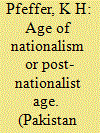

|
|
|
|
|
| Publication |
2009.
|
| Summary/Abstract |
Nationalist Europe of the 19th and 20th centuries was more progressive that the rulers and peoples of Africa and Asia, who until then lived in a pre-nationalist are of feudalism or tribalism. Similarly, now the contention is that the counries and peoples of Africa and Asia are passing through a historic phase which Europe has already left behind.
|
|
|
|
|
|
|
|
|
|
|
|
|
|
|
|
| 2 |
ID:
101589
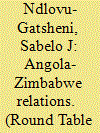

|
|
|
|
|
| Publication |
2010.
|
| Summary/Abstract |
The common approach to the study of foreign policies of Southern African Development Community (SADC) states is to locate them within the context of 'brother presidents' and 'sister liberation movements'. There is emphasis on liberation war camaraderie as a key variable. However, Angola-Zimbabwe (read as MPLA-ZANU-PF and MPLA-MDC) relations have no noticeable strong liberation war-time ties. The relations are traceable to the post-1980 period when the Zimbabwe African National Union-Patriotic Front (ZANU-PF) pursued a deliberate policy of integrating itself within the SADC region and this coincided with the Popular Movement for the Liberation of Angola's (MPLA) long-time desire to isolate its internal enemies of the National Front for the Liberation of Angola and the National Union for the Total Independence of Angola. What is also noticeable is the opacity and ambiguities in Angola-Zimbabwe relations, which have provoked growth of speculation and suspicion. The only time Angola and Zimbabwe openly collaborated was in their intervention in the Democratic Republic of Congo war in 1998 under the auspices of the SADC in general and the SADC Organ on Politics, Defence and Security in particular. However, two recent developments-the state visit to Luanda by the Prime Minister of Zimbabwe and the leader of the Movement for Democratic Change (MDC-T) Morgan Tsvangirai in October 2009, and the announcement by ZANU-PF of the China-Sonangol $8bn investment deal in November 2009-have provoked fresh interest in understanding Angola-Zimbabwe relations in the context of a regional initiative to resolve the Zimbabwe crisis. Although Angola is visible as a member of the SADC in the search for a solution to the Zimbabwe crisis, it has not openly expressed its foreign policy towards Zimbabwe. Unlike Botswana under Ian Khama and Zambia under the late Levy Mwanawasa, which openly criticised President Robert Mugabe and ZANU-PF over governance and its human rights record, Angola has remained quiet, making it hard to know its exact position vis-agrave-vis initiatives towards resolution of the Zimbabwe crisis. Interest in Angolan foreign policy is further motivated by the fact of its ascendancy as one of the regional powers; building on its rich mineral resources, it has the potential leverage to help in the resolution of the Zimbabwe crisis if it openly expressed its position. At the moment, it is not clear whether Angola has also adopted 'quiet diplomacy', just like South Africa under President Thabo Mbeki in its dealings with Zimbabwe.
|
|
|
|
|
|
|
|
|
|
|
|
|
|
|
|
| 3 |
ID:
106143
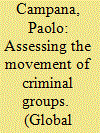

|
|
|
|
|
| Publication |
2011.
|
| Summary/Abstract |
The article offers a commentary on the push and pull framework outlined by Morselli, Turcotte and Tenti in the current issue of this journal. It argues that, when assessing the mobility of criminal groups, two key aspects deserve better recognition: first, the nature of the movement, namely whether the common fund and the 'headquarters' (including the boss) have been shifted from the old to the new locale; second, whether the group provides some kind of goods and services or is purely predatory. It maintains that both push and pull factors may vary according to those characteristics. Finally, the article empirically examines the movement of a Camorra crime group from Campania (Italy) to Scotland and the Netherlands, and reconstructs the underlying push and pull factors.
|
|
|
|
|
|
|
|
|
|
|
|
|
|
|
|
| 4 |
ID:
176021
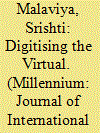

|
|
|
|
|
| Summary/Abstract |
This article offers a relational analysis of the use of armed drones in the ‘war on terror’. Drawing from Erin Manning’s writings on movement, relations, and the posthuman, I explore how bodies and spaces are read as digitised data in the processes of the drone assemblage, reducing movement to displacement and undoing relations of becoming. The drone’s violence lies in its crippling of bodies’ capacity to respond to their immediate environments and relations. The point of departure for this article is the concept of the ‘virtual’ as drawn out by Manning: the indeterminate potential of movement which moves bodies and relations. My analysis revisits the transcripts of Uruzgan drone attack in Afghanistan in 2010, a case that has been extensively studied in the critical literature on drones to offer conceptions of what it means for the drone to be a posthuman entity. Instead of situating the drone as a posthuman object, I examine it from a posthuman methodology where the focus is on relations, rather than determinate actors or outcomes. My intervention here is twofold: to propose a framework for understanding the drone’s violence in its processes of disrupting and undoing relations, and relatedly to argue for the methodological and theoretical value of the posthuman.
|
|
|
|
|
|
|
|
|
|
|
|
|
|
|
|
| 5 |
ID:
172134
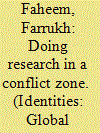

|
|
|
|
|
| Summary/Abstract |
This paper argues that in conflict zones like Jammu and Kashmir, the embodied stories of Kashmiris punctuate the past, often silenced by dominant Indian narratives. Narratives about certain key political events in the region's past co-exist with other forms of memory. Kashmiris weave these stories to make sense of the present, build connections to the past, and stake claims for the future. They build and nourish an archive based on lived experience, keeping a record of past wrongs. Novels, anecdotes and underground literature form part of this embodied archive, and provide a resource for recovering stories that remain silent in institutional archives which serve the interests of power. These interests are visible through restrictions on access to institutional archives, and demonstrate the effects of power and the overall politics of archives.
|
|
|
|
|
|
|
|
|
|
|
|
|
|
|
|
| 6 |
ID:
182854
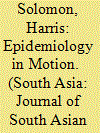

|
|
|
|
|
| Summary/Abstract |
This paper is an ethnographic account of traumatic brain injuries (TBIs) based on a study of a public hospital trauma ward in urban India. It explores the contexts, causes and consequences of TBIs in order to make several broader claims. Across two case studies, I argue that epidemiological transitions towards non-infectious disease regimens must be understood as problems of somatic movement. The implication is that bodies make transitions through actual and imagined changes in bodily movements that define how persons become patients, how traumatic injury pulls on clinical resources, and how differences in gender, sexuality, class and caste affect the social dynamics of brain injury in urban settings at every turn.
|
|
|
|
|
|
|
|
|
|
|
|
|
|
|
|
| 7 |
ID:
152442
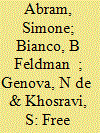

|
|
|
|
|
| Summary/Abstract |
This article contains the text and discussion of a debate held at the IUAES World Congress in Anthropology at Manchester University in 2013. The motion was proposed by Bela Feldman-Bianco (State University of Campinas), seconded by Noel Salazar (University of Leuven) and was opposed by Shahram Khosravi (Stockholm University), seconded by Nicholas de Genova (then at Goldsmiths’ College). The debate was chaired by Simone Abram (Durham University).
|
|
|
|
|
|
|
|
|
|
|
|
|
|
|
|
| 8 |
ID:
167405
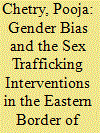

|
|
|
|
|
| Summary/Abstract |
The present article looks at gender bias and sex trafficking interventions in the eastern border of India–Nepal. It attempts to understand the socio-economic conditions and other influencing factors that circumscribe a woman’s migration. It documents the interventions by anti-trafficking networks and explores the experience of intercepted women. It attempts to show how interception methods as techniques of intervention to combat trafficking in persons are gender biased. Interception, as a primary method of intervention, is used by anti-trafficking organisations to prevent the occurrence of human trafficking cases in its origin/source country. On suspicion, a woman or a girl crossing the border alone or in all-female groups is stopped and intercepted by the anti-trafficking activists on the ground of her being a potential victim of sex trafficking. Such interception generally takes place within 3 km radius of the border of Panitanki, India, to Kakarbitta, Nepal in order to prevent the unsafe and illegal migration of girls/women. The cross-questioning method is used to extract information and validation about her identity and travel. This article, therefore, examines interception methods as techniques of intervention to combat trafficking in persons. It shows how this intervention method in certain aspect is patriarchal in its form. It reinforces the patriarchal belief of women’s vulnerability in the absence of male authority leading to discreet dangers.
|
|
|
|
|
|
|
|
|
|
|
|
|
|
|
|
| 9 |
ID:
089669
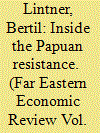

|
|
|
|
|
| Publication |
2009.
|
| Summary/Abstract |
The Indonesian election on July 8 seems likely to give Susilo Bambang Yudhoyono another five years in office. He is ahead of other candidates in opinion polls, and his Democratic Party emerged as the country's largest in the parliamentary elections in April. A high degree of normality and stability has returned to Indonesia after years of political and social turmoil. Only a decade ago, many feared that Indonesia would break up along ethnic lines and become a "Southeast Asian Yugoslavia.
|
|
|
|
|
|
|
|
|
|
|
|
|
|
|
|
| 10 |
ID:
175108
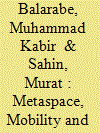

|
|
|
|
|
| Summary/Abstract |
The street vendor’s (SV) potential mobility in subverting authorities’ hegemony over public space has been theorised within the contexts of urban informality and resistance. Discussions mainly revolve around movement tactics as resistance strategy while evading arrests and confiscations. This negates SV agency and limits understanding mobility in resistance. Using Bunschoten’s metaspace and Cresswell’s aspects of mobility, this paper employs semi-structured interviews with mobile SV, road users and pedestrians in Kano (Nigeria), to describe vendors’ mobile practices and how they delay hostility from the state. Observing the interplay between vendors, users and environment, this paper identifies four types of vendor movement: focused, targeted, sporadic and self-regulatory; and examines how vendors exploit Cresswell’s speed and rhythm in challenging formal urban practice hegemony through continuous operation. The paper also describes how vendors’ movement affects other actors’ mobilities. Finally, the paper discusses urban design implications for integrating SV within city plans, setting out potential proposals.
|
|
|
|
|
|
|
|
|
|
|
|
|
|
|
|
| 11 |
ID:
185636
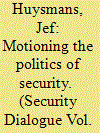

|
|
|
|
|
| Summary/Abstract |
The article explores challenges that giving conceptual primacy to movement poses for thinking the politics of security. In security studies, there has been an intense interest in mobile phenomena and the nature of security techniques that seek to control, contain or steer them. However, when exploring how these mobile phenomena bear upon conceptions of politics and their contestation, the analytics tend to turn back to more static or sedentary categories and reference points. Against this background, the article develops an analytical framework for security and its politics that gives conceptual primacy to movement. Giving conceptual primacy to movement implies three key moves: (a) changing lines from enclosures and connectors to pathways; (b) shifting from understanding movement through positions and nodes to the continuity of movement; and (c) displacing architectural and infrastructural readings of the relations between movements with readings of continuously unfolding confluences of movements moving in relation to one another. Applying these three moves displaces conceptions of movement as border crossings and networked connections with the notion of entangling movements moving in relation to one another. One of the implications for security studies is that taking such a point of view challenges the use of ‘the subject of security’, understood in terms of state sovereignty and the positioning of differential security claims hooked into group identity, as a key device for making security politically meaningful and contested. The article concludes that giving conceptual primacy to movement invites security studies not to limit itself to studying the politics of movement but to also incorporate a motioning of politics.
|
|
|
|
|
|
|
|
|
|
|
|
|
|
|
|
| 12 |
ID:
107546
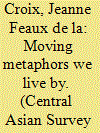

|
|
|
|
|
| Publication |
2011.
|
| Summary/Abstract |
Based on anthropological fieldwork between 2006 and 2008, this article compares how people in the Toktogul region of Kyrgyzstan understand and interact with water in three highly significant places: mountain pastures (jailoos), the Toktogul hydroelectric dam that controls the flow of the Naryn and sacred sites (mazars). Sidelining the vast standing waters of Toktogul Reservoir, valley residents instead highlight the positive qualities of flowing water at mazars, pastures and the working dam. Contrasting how metaphors of running water are put to use conceptually by Toktogul residents and social scientists opens up a critique of current academic and policy-oriented descriptions of the world as 'flow'. Attention to a particular kind of movement (flowing water) highlights some of the silent assumptions in current depictions of a mobile world 'in flux'.
|
|
|
|
|
|
|
|
|
|
|
|
|
|
|
|
| 13 |
ID:
146152
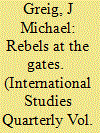

|
|
|
|
|
| Summary/Abstract |
In this paper, I build upon the conflict management, civil war, and bargaining literatures to develop and test a theoretical model that links openings for diplomacy to where civil war battles occur and how these locations change over time. I argue that the locations and movements of civil war battles provide information to both governments and rebels that influences their willingness to engage in mediation and negotiation. By identifying how civil war battles influence the willingness of warring sides to participate in diplomacy, I suggest that it is possible to identify other windows of opportunity for effective conflict management beyond waiting for a conflict to evolve into a hurting stalemate. The results of my analysis of 46 African civil conflicts shows that battle locations, battle velocity, and battle dispersion each influence the occurrence and outcomes of peace talks.
|
|
|
|
|
|
|
|
|
|
|
|
|
|
|
|
| 14 |
ID:
164378
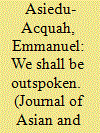

|
|
|
|
|
| Summary/Abstract |
This paper looks at student political activism in Ghana in the late 1950s and 1960s. Using Ghanaian and British archives, it examines how students of Ghana’s universities politically engaged with the government of Kwame Nkrumah and his ruling Convention People’s Party (CPP). Student activism manifested most in the conflict between the Nkrumah government, on one hand, and university authorities and students, on the other hand, over the purpose of higher education, university autonomy, and nationalism. The conflict coalesced around the idea of educated youth as model citizens. Contrary to the denial in existing literature, the paper argues that a nascent student movement and tradition of student political activism had emerged since the late 1950s. University student activism established itself as a fulcrum of the country’s evolving postcolonial political order and a bulwark against governmental authoritarianism. In the larger context of the global 1960s, Ghanaian student activism belonged to the wave of youth protests against governments that favored stability and opposed all dissent.
|
|
|
|
|
|
|
|
|
|
|
|
|
|
|
|
|
|
|
|
|